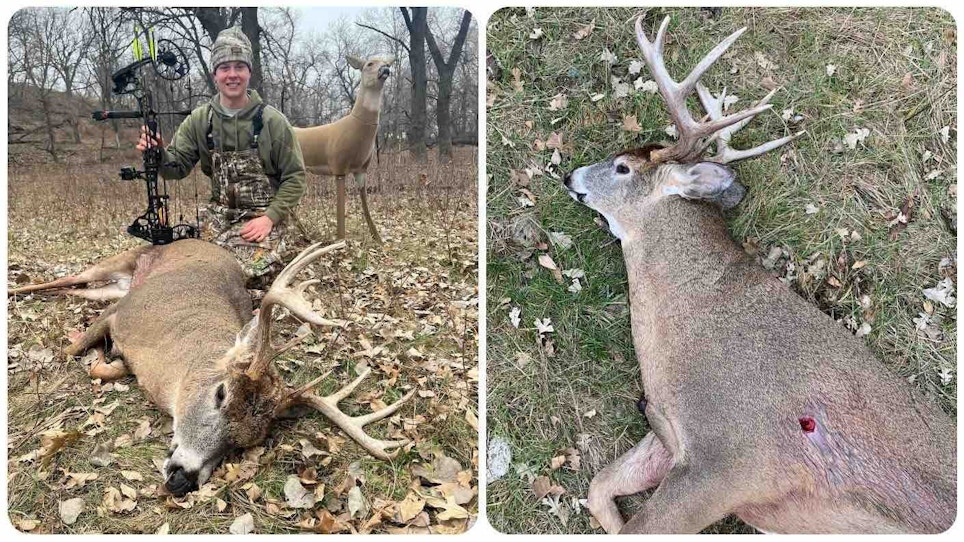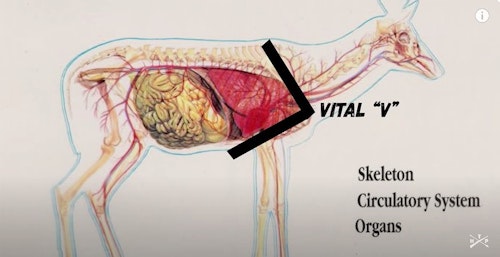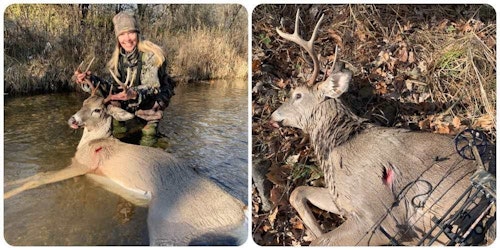
Striking a whitetail in the vital V results in a quick, clean kill. This buck ran 60 yards after the shot and was dead in no more than 15 seconds.
The topic of where to aim on a broadside big game animal can be controversial among some bowhunters, but to me there’s only one right answer — the “vital V.” By the vital V, I mean the front of the lungs; just below the shoulder bone (scapula), and right over the leg bone.

The controversy comes from bowhunters who believe it’s smart to aim further away from the shoulder bone to avoid hitting it. I disagree 100 percent with this argument, and here are three reasons why.
1. Shoulder-Hit Animals Will Almost Always Survive
Although I’m not proud to admit it, I have hit the shoulder bone of whitetails on a couple of occasions during my 45 years of bowhunting. Do I feel horrible for making a bad hit? Absolutely.
Because I draw a fairly lightweight bow (54 pounds), my arrows aren’t zipping through scapulas, even though my arrows (fairly heavy) are tipped with a 125-grain razor-sharp, cut-on-contact, fixed-blade broadhead. The arrow penetrates a couple of inches then stops.
Of course, I follow up on any hit deer, and usually the blood trail on a shoulder-hit deer is sparse for about 200 yards, then it basically stops. I’ve had shoulder-hit deer show up on trail cams a day or two later, and they are moving and feeding normally.
2. Animals Hit Too Far Back Will Almost Always Die
When you read this reason No. 2, you might ask yourself, Isn’t killing the animal the goal? Well, yes and no.
If your arrow penetrates the paunch, which in my experience is the most common bad hit for bowhunters who aim further back to avoid any chance of striking the shoulder, then the animal will die — eventually. But our goal as bowhunters must be for quick, clean kills.
In my opinion, it’s not okay to send a 2-inch mechanical into a buck’s paunch, celebrate with your buddies that the deer will die, then head back to camp with a smile on your face.
Sure, if you don’t pursue the deer after a paunch hit, it will likely bed within 150 yards and be dead after a dozen hours. If the temperatures are cold, the meat will still be fine. Even so, I experience zero joy in recovering a pauch-hit animal. I literally apologize to the animal; it didn’t deserve to die this way.
3. Vital V Hits Result in Quick Death
As I stated earlier, our goal as bowhunters is for a quick, clean death. When a sharp broadhead penetrates the vital V, the animal will die in seconds and often within sight of your ambush position.
When I think back over the last handful of years and remember whitetails that were hit in the vital V by me and my friends, I’m continually amazed at how lethal a well-placed sharp broadhead can be. It’s common for a deer hit in the vital V to run no more than 50 yards and be dead in less than 10 seconds. And in my experience, if you choose a razor-sharp, cut-on-contact, fixed-blade broadhead, the animal often bounds away only a jump or two; it’s almost like they think they were stung by a bee. I’ve even had them resume feeding for a second or two before they fall to the ground.

Aiming for the Vital V
To hit the vital V on a broadside animal, aim right over the animal’s near front leg — not an inch or two or three behind it. The leg bone angles forward; it doesn’t cover the chest. It’s this leg bone that forms the bottom of the vital V boundary. The shoulder bone forms the upper boundary of the vital V.
Aim one-third to halfway up from the animal’s bellyline, depending on whether you’re on the ground or in a treestand. Your arrow must enter the animal higher from a treestand for an arrow to penetrate both lungs.
Check out the informative “Where to Aim With a Bow” YouTube video below from the guys at The Hunting Public. Not only do they demonstrate the lethality of vital V hits on whitetails, but they explain how 3-D targets often mislead bowhunters into aiming too far back. They also provide great tips on how to minimize deer jumping the string, where to aim when it’s likely a deer will react to the shot, and taking a few extra seconds to aim precisely before shooting.





